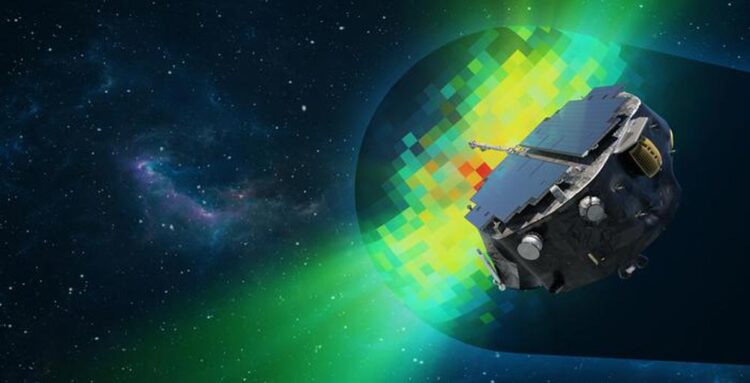NASA’s Interstellar Mapping and Acceleration Probe passes system integration review

IMAP will study the protective magnetic bubble that surrounds our solar system, called the heliosphere, and the particle acceleration that occurs across it.
Credit: NASA/Princeton/Johns Hopkins APL/Josh Diaz
The Interstellar Mapping and Acceleration Probe (IMAP) marked the completion of an important step on the path to spacecraft assembly, test, and launch operations this week at Johns Hopkins Applied Physics Laboratory (APL) in Maryland.
The IMAP team met with a review panel to evaluate the plan for integrating all systems onto the spacecraft, such as the scientific instrumentation, electrical and communication systems, and navigation systems. Successful completion of this System Integration Review (SIR) means that the project can proceed with assembling and testing the spacecraft in preparation for launch. This process is a bit like a carefully choregraphed dance where the instruments and support systems are delivered to different facilities, tested together in chambers in Los Alamos, New Mexico; San Antonio, Texas; and Princeton, New Jersey; and shipped back to be integrated and tested again altogether.
On Friday, Sept. 15, 2023, the chair of the Standing Review Board announced that the IMAP project successfully passed the SIR requirements to proceed to integration and test.
“I am incredibly proud of the entire IMAP team for everyone’s hard work and determination in getting us to and through this critical milestone,” said David McComas, IMAP mission principal investigator and Princeton University professor. “We are now moving on to spacecraft integration and test, where all of the individual subsystems and instruments merge together to create our full IMAP observatory.”
The IMAP mission, which will be ready to launch in 2025, will explore our solar neighborhood, decoding the messages in particles from the Sun and beyond our cosmic shield. The mission will map the boundaries of the heliosphere – the electromagnetic bubble surrounding the Sun and planets that is inflated by the solar wind.
David McComas leads the mission with an international team of more than 20 partner institutions. APL is managing the development phase, building the spacecraft, and will operate the mission. IMAP is the fifth mission in NASA’s Solar Terrestrial Probes (STP) Program portfolio. The Explorers and Heliophysics Projects Division at NASA’s Goddard Space Flight Center in Greenbelt, Maryland, manages the STP Program for the agency’s Heliophysics Division of NASA’s Science Mission Directorate.
For more information about IMAP visit: https://imap.princeton.edu
Media Contacts
Abbey Interrante
NASA/Goddard Space Flight Center
abbey.a.interrante@nasa.gov
Denise Hill
NASA
denise.hill@nasa.gov
All latest news from the category: Physics and Astronomy
This area deals with the fundamental laws and building blocks of nature and how they interact, the properties and the behavior of matter, and research into space and time and their structures.
innovations-report provides in-depth reports and articles on subjects such as astrophysics, laser technologies, nuclear, quantum, particle and solid-state physics, nanotechnologies, planetary research and findings (Mars, Venus) and developments related to the Hubble Telescope.
Newest articles

NASA: Mystery of life’s handedness deepens
The mystery of why life uses molecules with specific orientations has deepened with a NASA-funded discovery that RNA — a key molecule thought to have potentially held the instructions for…

What are the effects of historic lithium mining on water quality?
Study reveals low levels of common contaminants but high levels of other elements in waters associated with an abandoned lithium mine. Lithium ore and mining waste from a historic lithium…

Quantum-inspired design boosts efficiency of heat-to-electricity conversion
Rice engineers take unconventional route to improving thermophotovoltaic systems. Researchers at Rice University have found a new way to improve a key element of thermophotovoltaic (TPV) systems, which convert heat…



